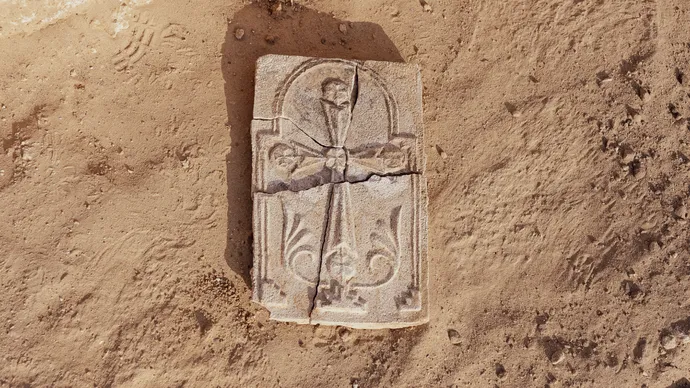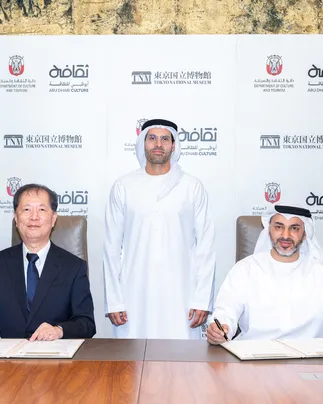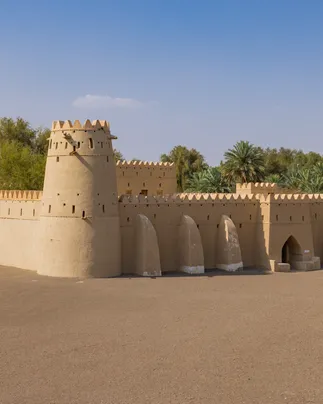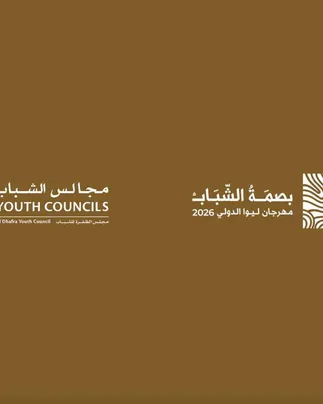The Department of Culture and Tourism - Abu Dhabi (DCT Abu Dhabi) has announced the discovery of a cross moulded on a stucco plaque from the ancient monastery on Sir Bani Yas Island, off the coast of Al Dhafra Region in Abu Dhabi.
The find, made during the first major excavation on the island in more than 30 years, serves as a reminder of the deep rooted traditions of peaceful coexistence in the UAE.
In January 2025, DCT Abu Dhabi launched a new fieldwork campaign on Sir Bani Yas Island, leading to the discovery of a Christian cross moulded on a plaster plaque, an object believed to have been used by monks for spiritual contemplation. The style of the cross shows similarities with finds from Iraq and Kuwait, and is linked to the Church of the East, which has origins in ancient Iraq.
This discovery underscores DCT Abu Dhabi’s ongoing commitment to uncovering and preserving the emirate’s rich cultural heritage, reinforcing the UAE’s legacy of coexistence, peace, and tolerance.
His Excellency Mohamed Khalifa Al Mubarak, Chairman, DCT Abu Dhabi, said, “The discovery of this ancient Christian cross on Sir Bani Yas Island is a powerful testament to the UAE’s profound and enduring values of coexistence and cultural openness. It stirs within us a deep sense of pride and honour and reminds us that peaceful coexistence is not a modern construct, but a principle woven into the very fabric of our region’s history.
“The ongoing discoveries from Sir Bani Yas Island, even after 30 years of research and excavation, underscore the magnitude of our cultural legacy and the importance of our continued commitment to its preservation and understanding. As DCT Abu Dhabi continues to uncover these valuable stories, we reaffirm our dedication to preserving, promoting, and protecting Abu Dhabi’s diverse heritage, one that we are honoured to share with the world. These discoveries deepen our connection to the past and inspire future generations to embrace the spirit of unity and mutual respect that has long defined our community.”
A seventh-to eighth-century CE Christian monastery was first discovered on Sir Bani Yas Island in 1992 by the Abu Dhabi Islands Archaeological Survey (ADIAS), under the direction of the UAE’s leadership. Excavations since then have uncovered a church and a monastic complex occupied at the same time as the monastery. They are currently interpreted as separate spaces, where senior monks retreated for periods of contemplation and ascetic seclusion.
Archaeologists are currently researching and exploring a group of courtyard houses near the monastery, where early Christian monks lived in retreat.
Sir Bani Yas is part of a wider group of churches and monasteries that emerged across the region around the same period, with similar sites found in Umm Al Quwain, Kuwait, Iran, and Saudi Arabia. Christianity spread and declined across the Arabian Peninsula between the fourth and sixth centuries CE. Christians and Muslims later co-existed until the eighth century CE, when the Sir Bani Yas monastery was peacefully abandoned. Today, the church and the monastery, set within nature reserves home to gazelles and hyrax, serve as a reminder of Abu Dhabi’s ancient past.
As part of restoration efforts carried out by DCT Abu Dhabi in 2019, the church and monastery are now protected by shelters. The Sir Bani Yas church and monastery site has reopened to the public with improved facilities, including directional signage and a small exhibition of artefacts from previous excavations, such as glass chalices, a cross-shaped stucco, and a stamp seal with a scorpion motif. A multi-faith church, inspired by the ancient site, has also been built adjacent to the visitor centre.
DCT Abu Dhabi will continue excavating the courtyard houses in the coming years, which may be integrated into a wider visitor trail connecting the island’s cultural landmarks.










